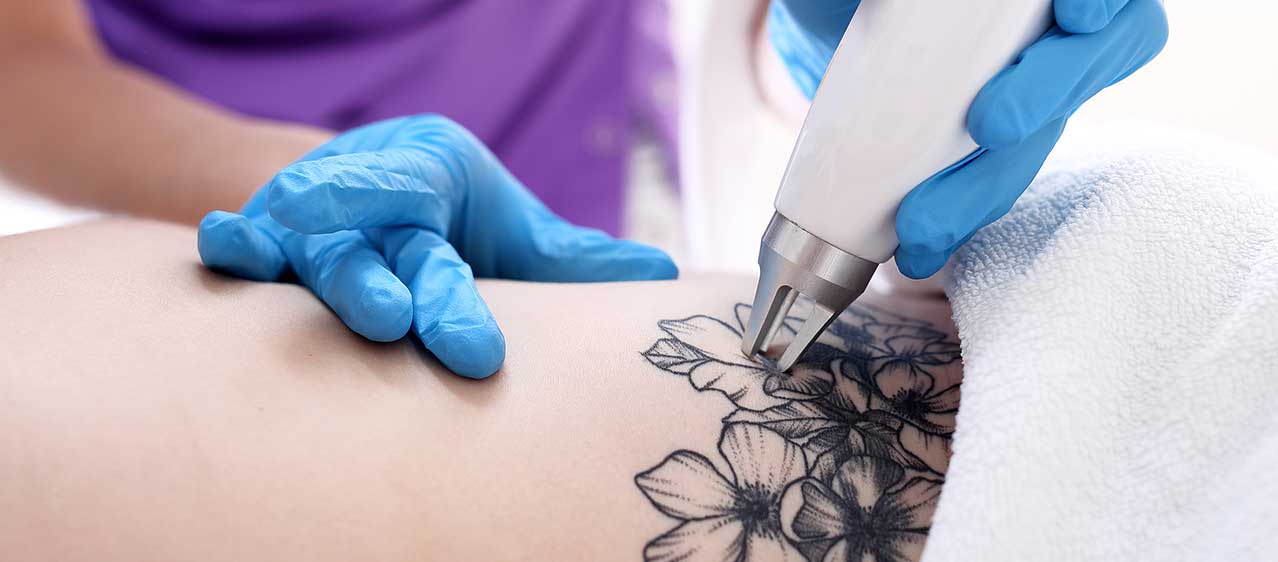
Self expression is a wonderful thing, but so is the ability to change your mind. In this day and age it seems like everyone and their mother has a tattoo (or three), and it seems like more than ever the average person may be jumping into an impulsive novelty tattoo. Sure, it was clever at the time, but now you’re a totally different person and it just doesn’t hold the same appeal it once did. The good news is that nothing is permanent.
For quite some time laser tattoo removal has been held as the industry standard for treating unwanted ink, but it comes with some drawbacks, most notably that it simply does not work on certain colours of ink, and is not as effective for darker skin types. Other not-so-nice effects from laser tattoo removal include:
- Blistering and burning
- Swelling and bruising
- Pinpoint bleeding and crusting
- Muscle and tissue soreness
- High risk of scarring, hyper- and hypo-pigmentation in darker skin types
- High risk of liver and kidney toxicity (more on this later!)
Nothing is 100% risk-free, however if not every skin type can have the procedure performed effectively, and not every colour of pigment can be treated… why choose laser? Well, simply because it has been the only option available to us with the least amount of risk. Things like dermabrasion (no, nothing like our microdermabrasion) and surgical excision used to be the only options outside of laser, and your risk of scarring is just about 100%.
Tattoo Removal for All Skin Types Colours
Since we strive to offer treatment options to all skin types with the same great results, we opted for a removal method which can be successfully performed on all skin types and all colours. Have you heard of DP Tattoff?
Tattoff is an extension of our beautiful Dermapen Microneedling device. A specialized needle cartridge is used to infuse a polylactic compound into the dermis — think of it like tattooing in reverse. Rather than the needles depositing ink into the skin, the polylactic compound instead denatures the tattoo pigment causing it to be pulled up through the skin.
How Exactly Does Laser Work?
Laser tattoo removal works on a chromophore, meaning that it is attracted to a pigment — particularly the darkest pigments. Because of this, the success of laser tattoo removal is like smashing a glass on the kitchen floor: If you drop the glass from a short enough distance, it should break into large enough pieces that it’s relatively easy for you to sweep it up. However, if you break the glass and then go and put your shoes on and start stomping the class into tiny particle size, you’ll then have a much harder time cleaning up the glass as it starts to get stuck between the tile grout or floorboards. Imagine the glass is your tattoo ink and the laser your stomping shoes.
Much like IPL removing dark sun spots from the skin, once the ink pigment has been broken into tiny pieces, your lymphatic cells are then able to come carry them away and flush them out through your lymphatic system. Now, for naturally produced pigment such as melanin, this is no problem. However, remember that liver and kidney toxicity thing we mentioned? Being as the ink is being flushed through the lymphatic system, it means that it’s going through a full body process through your organs (hello, liver and kidneys).
For unnaturally produced pigment this can be problematic. Do you know exactly what is in the ink that makes up your tattoos? Most people don’t. If your tattoo was done on a beach in Thailand, for example, you can almost be guaranteed that it’s not proper, high quality tattoo ink. So if you then start lasering that in large surface areas, the issue becomes that any toxic components are now making their way through your liver and kidneys.
Technically speaking, because of this potential toxicity, you can only treat roughly a hand-span per treatment. If you over treat that, you risk overloading the lymphatic system and as a result overloading the liver and kidneys. If your tattoo was done with really dodgy ink, this can then either move you into blood poisoning or infection.
Laser comes with even more drawbacks now once you begin to start over-fading or over-treatment the tattoo. Biologically what ends up happening is that you make the ink particles so small that the body no longer views them as a pathogen, or something it needs to work to get rid of. This leaves you with shadowing. Once you’ve reached shadowing with a tattoo, no amount of laser will remove it further. The further risk now is that an inexperienced technician may try to get around this by increasing the energy or depth of treatment, which now puts you at a high risk for burns and scars.
Another interesting note is that we see a lot of tattoo removal with laser, but no one is entirely sure where it goes. If treated ink particles were to be excreted through urine, you would have a few flows where you would be peeing out blue, for example. Likewise also if it was excreted through sweat, you would be able to see this pigment exiting through the pores. So once we break that pigment up with laser, we’re not actually entirely sure where it will go. This is why potential toxicity and not over treating a large area again becomes exceptionally important.
Introducing Tattoff
Quick, effective and precise, Tattoff is able to remove all types of tattoos, including whole tattoos or just parts — have an “oops” in your art? — and even cosmetic tattoos from the eyebrows. DP Tattoff removes ALL COLOURS, is effective on all skin types and is quick, safe, affordable and largely pain-free. The average sized tattoo requires between 4-6 sessions, but this depends on a variety of factors including skin type, age of the tattoo, age of the candidate, amount of pigment, location of the tattoo and history of other removal attempts (i.e. laser).
While we can perform Tattoff on all skin types, it is important still that precautions are taken in darker skin types. In order for a tattoo to remain permanent, the tattoo ink must penetrate the dermis (the deepest layer of the skin). Therefore, any removal method must also reach the dermis without causing significant trauma to the epidermis. This matters because our epidermis is where our pigment-producing melanocyte cells live. The problem with laser and darker skin types is that some of these melanocyte cells may be removed with the tattoo ink, resulting in hypopigmentation, this is because the laser cannot clearly differentiate what is melanin and what is tattoo pigment and so it removes it all.
Location of the tattoo will also have a role in determining the success of removal, as well as the risk of scarring. The body’s natural “cleanup” mechanism, the lymphatic system, relies on the presence of a complex supply of blood vessels and lymph nodes, meaning the higher the vessel and lymph node count in an area, the more aggressive the cleanup. Since these things vary according to the region of the body, so too will the level of “cleanup” done by the body. For example, the head and neck have the largest number of lymph nodes, whereas areas like the wrists or ankles have the least.
If you’re removing your tattoo, you might already know that picking the right artist matters. In the case of removal, sometimes an amateur tattoo means an easier removal process because the pigment is typically placed less deep in the skin, and less ink is deposited. This is why amateur tattoos respond so well to laser removal. A tattoo done by an experienced tattooist are most often layered and properly placed.
No matter what method of tattoo removal you choose, it is important to understand that the existing tattoo may already have scarring present below the surface, which can make the pigment removal process more difficult and harder to pre-determine a number of sessions for complete removal. When you run your fingers across your tattoo, if you feel any texture or raised points along the lines, this means scarring is present.
The Nitty Gritty
What actually happens when you come in for DP Tattoff? It may sound like we’re oversimplifying things by saying this, but truly it is like tattooing in reverse. The device and sensation is actually identical to the initial tattoo application. This mechanism is not brand new by any means, the technology has been used consistently from the 1950s onwards, we’ve just modified and made advancements with it.
Despite the concept of this kind of removal not being new, the risk in the past has always been that if you free hand this method, in other words if you dip a needle or tattoo applicator into a chemical solution and then insert that into the skin, you are allowing that solution to work all the way down, interact with the tattoo, but then work all the way back up to the top. This is not ideal as it almost guarantees adverse reactions. The innovation is to update this older technique and to ensure safety, which is what DP Tattoff has done successfully.
With the Tattoff device, we have a single-use, disposable needle cartridge which contains 7 needles within it, and the needles all sit at a point. This means that our solution now sits just between the needles as opposed to sitting on the end, which physically needs to go through the skin and back up. So now we have more of an injectection-type-technique: needles go in, distribute the solution, stop, and then the needles come out. So now we have physically placed the solution without allowing it to work through the top to bottom, then back up again.
As the polylactic compound (lactic acid) interacts with the tattoo pigment, it creates a reaction which triggers your body’s natural wound healing response and ultimately forms a scab that creates a vacuum around the treated area. This vacuum-like action is a result of the natural process in play: as the micro-injury tightens up top, this suction begins to occur as the body tightens and seals the area, which ultimately draws the pigment upwards. The fancy term for this mechanism is trans-epidermal pigment release.
The biggest advantage here is that this means the ink is not systemically absorbed. It does not go through your lymphatic system, so it does not go through your liver or kidneys, so as such you are able to safely treat any tattoo without potential toxicity. And, since we’re creating a “chemical” reaction as opposed to a thermal reaction, it doesn’t matter what colour it is which means that all colours, hues and shades can be treated effectively.
Another disadvantage of laser tattoo removal is that because tattoo ink if often place in a sort of zigzag method, when treating to a certain depth with laser, anything above or below this zigzag pattern doesn’t get treated. This means your technician is constantly adjusting the laser depth, but if they go too deep you can get a first or second degree burn deep within the tissue. As a technician, this is particularly difficult when working on something applied by a human. Since every artist may have varying depths of ink placement based on their technique, there is no safe way to determine how far to treat with laser. With DP Tattoff, we have created safety in this without coming at the expense of results and comfort.
Ready to erase your regrets? Book your complimentary TATTOFF consultation!


